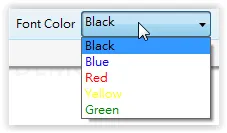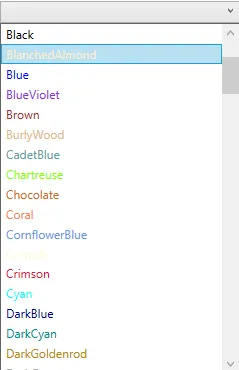我创建了一个ComboBox,列出了System.Windows.Media.Colors预定义的颜色,使用了这个问题中提到的方法:如何在WPF中使用XAML列出颜色?
我的XAML代码现在是:
<Window ...>
<Window.Resources>
<ObjectDataProvider
ObjectInstance="{x:Type Colors}" MethodName="GetProperties" x:Key="ColorList" />
<local:StringToBrushConverter x:Key="FontColorConversions" />
</Window.Resources>
<Grid Background="Black">
...
<ComboBox Grid.Column="1" Grid.Row="1" Height="22" Width="240"
VerticalAlignment="Center" HorizontalAlignment="Left"
ItemsSource="{Binding Source={StaticResource ColorList}}"
SelectedValue="{Binding FontColor, Mode=TwoWay}"
DisplayMemberPath="Name"
SelectedValuePath="Name">
<ComboBox.ItemContainerStyle>
<Style TargetType="ComboBoxItem">
<Setter Property="Foreground" Value="{Binding Converter={StaticResource FontColorConversions}}"/>
</Style>
</ComboBox.ItemContainerStyle>
</ComboBox>
...
</Grid>
</Window>
此外,请注意,我将SelectedValue绑定到一个VM类的FontColor属性上,该属性的类型为字符串。
class FontSetting : INotifyPropertyChanged
{
private string _fontColor = "Lavender"; // initial color
public event PropertyChangedEventHandler PropertyChanged;
public string FontColor
{
get
{
return _fontColor;
}
set
{
_fontColor = value;
OnPropertyChanged("FontColor");
}
}
protected virtual void OnPropertyChanged(string propertyName)
{
var handler = PropertyChanged;
if (handler != null)
{
handler(this, new PropertyChangedEventArgs(propertyName));
}
}
}
我将包含此ComboBox的窗口的DataContext设置为FontSetting的实例。
因此,现在ComboBox中的每个项目实际上显示代表某种颜色的字符串,我想要做的是将项目的前景色设置为其内容指示的颜色,就像这样:
有人能帮忙吗?谢谢。
更新: 由于大多数解决方案都有一个将字符串转换为Brush的转换器,而实际上我已经有了它,现在我想把我的代码放在这里,因为我将一个TextBox的前景绑定到FontSetting的FontColor属性上,所以当您更改ComboBox时,该TextBox的颜色会相应地更改。
这是我的转换器类,现在它运行得很好:
class StringToBrushConverter : IValueConverter
{
public object Convert(object value, System.Type targetType, object parameter, System.Globalization.CultureInfo culture)
{
BrushConverter conv = new BrushConverter();
SolidColorBrush brush = conv.ConvertFromString("Lavender") as SolidColorBrush;
if (null != value)
{
brush = conv.ConvertFromString(value.ToString()) as SolidColorBrush;
}
return brush;
}
public object ConvertBack(object value, System.Type targetType, object parameter, System.Globalization.CultureInfo culture)
{
return null;
}
}
当我点击下拉列表框以打开下拉列表时,出现了异常:
结论
Amine的解决方案可行,是我的错误。现在我简要解释一下,如果将ComboBox绑定到System.Windows.Media.Colors,就像我所做的那样,当项目被呈现时,转换器类的Convert()方法(您分配给绑定的方法)将被执行,实际上传递给Convert()作为其第一个参数的值是Syetem.Windows.Media.Color实例。我犯了错误,因为我认为它是字符串类型。
因此,在我的情况下,我需要两个转换器类,一个将字符串转换为Brush,另一个将Color转换为Brush。因此,我将保留自己的StringToBrush转换器并添加Amine的ColorToBrush转换器。
但是,我稍微简化了Amine的实现:
public object Convert(object value, Type targetType, object parameter, CultureInfo culture)
{
BrushConverter conv = new BrushConverter();
SolidColorBrush brush = SolidColorBrush)conv.ConvertFromString(FontSetting.DEFAULT_FONT_COLOR);
if (null != value)
{
PropertyInfo pi = value as PropertyInfo;
if (null != pi)
{
brush = conv.ConvertFromString(pi.Name) as SolidColorBrush;
}
}
return brush;
}
此外,Joe的意见也非常有价值,将它们汇总起来,我可以保持物品的颜色一致,这非常完美。



Value="{Binding Converter={StaticResource converter}}",你有没有漏掉什么?你不需要指示绑定从哪个源获取值吗? - VincentZHANG